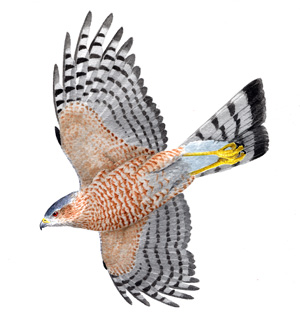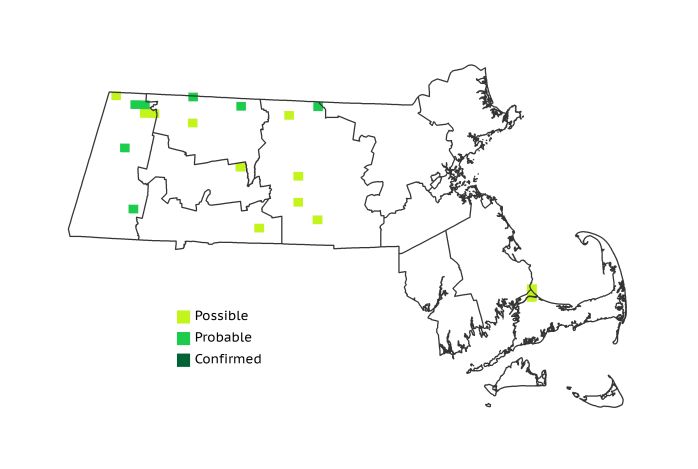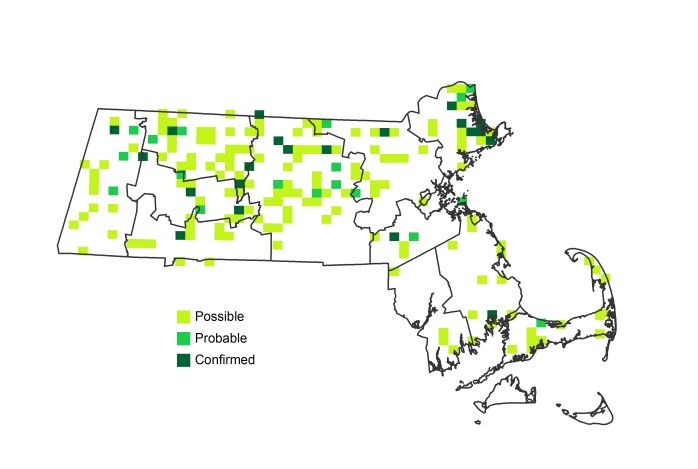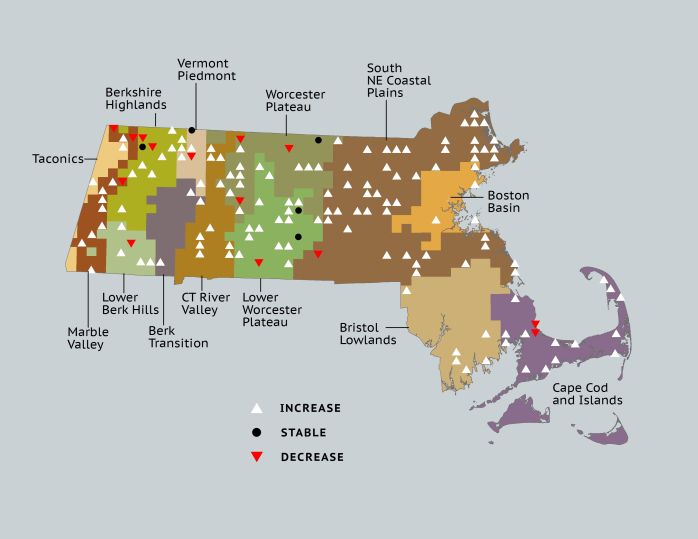Find a Bird
Sharp-shinned Hawk
Accipiter striatus

Local and strongly increasing
Species of Special Concern

“Many have been the times, reader, when watching this vigilant, active, and industrious bird, I have seen it plunge headlong among the briary patches of one of our old fields, in defiance of all thorny obstacles, and, passing through, emerge on the other side, bearing off with exultation in its sharp claws a Sparrow or Finch, which it had surprised when at rest.” - John James Audubon, Birds of America
Many a backyard birder is introduced to the Sharp-shinned Hawk when one sweeps suddenly out of cover and reduces a titmouse or chickadee to a pitiful pile of feathers in a matter of seconds. Indeed, perhaps few raptors are any more familiar in the depths of a Massachusetts winter than this one, which has for years stalked the bird feeders of suburban residents looking for its next meal. But when breeding season comes along these small and agile hawks seemingly disappear, becoming veritable phantoms in the summer woods where they nest.
Historic Status
The secretiveness of the Sharp-shinned Hawk, or “Chicken Hawk,” while breeding has made it difficult to piece together its history in Massachusetts. While widespread historic habitat changes suggest that during the period when the state was mostly forested, “Sharp-shins” could have successfully bred in Massachusetts, no nesting records exist. Even though ornithologists and bird lovers across the state regularly recorded the Sharp-shinned Hawk in migration and even occasionally in summer, by 1901 Reginald Heber Howe and Glover Morrill Allen boldly stated in their The Birds of Massachusetts, “Notwithstanding statements to the contrary, there is no authentic record of the nesting of this bird in Massachusetts.” As the state reverted to forest during the twentieth century, the potential for the species to breed in Massachusetts increased, although, if it did breed, it remained undetected.
Atlas 1 Distribution
Records of breeding Sharp-shinned Hawks in Atlas 1 were scattered and rare, which may have been due as much to the species’ secretiveness as well as to its scarcity. In fact, nesting Sharp-shinned Hawks were so elusive that not a single nest was found. The Berkshire Highlands and the Marble Valleys together accounted for 32% of all occupied blocks, while the Worcester and Lower Worcester Plateau area accounted for 37%. Other records were thinly distributed, mostly in other central and western regions. Two blocks on either side of the Cape Cod Canal reported Possible Sharp-shinned Hawk breeding activity, though it seems likely that these reports could also have referred to the same individual.
Atlas 2 Distribution and Change
Increases in forest cover as well as continuing legal protection from persecution likely teamed up to result in a larger number of blocks hosting Sharp-shinned Hawks in Atlas 2. Every western ecoregion had at least a couple of occupied blocks, and the well-wooded Berkshire Highlands boasted 22% block occupancy. The patchwork landscape of the Connecticut River Valley supported breeding Sharp-shins in almost a quarter of the region, but that was a paltry total compared with figures from the Worcester Plateau and Lower Worcester Plateau regions. Accipiters maintain a notoriously low profile while nesting, but a handful of Confirmations nonetheless came through to complement the many Possible blocks throughout those central ecoregions. Sharp-shinned Hawks were fairly well distributed in the Coastal Plains, especially the northern half of the region and around the well-birded Essex County coast. They were more scarcely encountered in the Boston Basin and Bristol/Narragansett Lowlands, but they were widespread across Cape Cod.
Atlas 1 Map

Atlas 2 Map

Atlas Change Map

Ecoregion Data
Atlas 1 | Atlas 2 | Change | ||||||
Ecoregion | # Blocks | % Blocks | % of Range | # Blocks | % Blocks | % of Range | Change in # Blocks | Change in % Blocks |
Taconic Mountains | 0 | 0.0 | 0.0 | 2 | 8.0 | 1.1 | 2 | 13.3 |
Marble Valleys/Housatonic Valley | 3 | 7.7 | 15.8 | 9 | 23.1 | 4.8 | 6 | 15.4 |
Berkshire Highlands | 3 | 5.5 | 15.8 | 12 | 21.8 | 6.4 | 7 | 13.2 |
Lower Berkshire Hills | 1 | 3.6 | 5.3 | 4 | 12.9 | 2.1 | 3 | 11.1 |
Vermont Piedmont | 2 | 11.8 | 10.5 | 6 | 35.3 | 3.2 | 2 | 16.7 |
Berkshire Transition | 0 | 0.0 | 0.0 | 5 | 12.5 | 2.7 | 3 | 9.7 |
Connecticut River Valley | 0 | 0.0 | 0.0 | 16 | 24.6 | 8.5 | 9 | 18.8 |
Worcester Plateau | 4 | 5.1 | 21.1 | 29 | 33.0 | 15.4 | 10 | 20.8 |
Lower Worcester Plateau | 3 | 4.1 | 15.8 | 21 | 26.3 | 11.2 | 14 | 25.9 |
S. New England Coastal Plains and Hills | 1 | 0.4 | 5.3 | 57 | 20.1 | 30.3 | 45 | 19.9 |
Boston Basin | 0 | 0.0 | 0.0 | 4 | 7.1 | 2.1 | 4 | 7.3 |
Bristol and Narragansett Lowlands | 0 | 0.0 | 0.0 | 6 | 5.3 | 3.2 | 6 | 5.9 |
Cape Cod and Islands | 2 | 1.5 | 10.5 | 17 | 11.8 | 9.0 | 12 | 10.0 |
Statewide Total | 19 | 2.0 | 100.0 | 188 | 18.1 | 100.0 | 123 | 14.8 |



